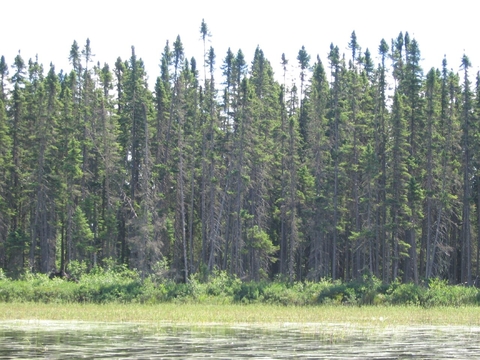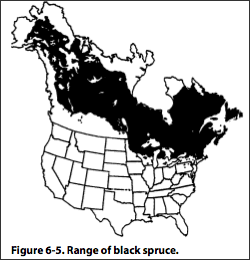Quick facts
- Black spruce is mainly found on soils with peat and muck.
- Rotation lengths for black spruce range from 60 to 140 years.
- Seedling establishment requires a ground surface that is moist and free from competing plants.
- A broadcast burn eliminates woody debris, undesirable small trees and shrubs.
- Clear-cutting blocks or strips is the best method for harvesting and reproducing black spruce.
Black spruce is almost exclusively grown for pulpwood. In the past, Christmas trees were cut from the top 3 feet of old trees that were 20 to 35 feet tall and growing on poor sites.
The spruce grouse depends on the black spruce for most of its habitat needs, and several songbirds use this forest type in summer.
Growing conditions
The black spruce forest type is mainly found on histosols, or soils with peat and muck, in the Lake States (Minnesota, Wisconsin and Michigan). It is also common on drier soils in mixture with other species.
On organic soil, black spruce mainly grows in pure stands. It can also be mixed with tamarack, northern white cedar and balsam fir.
On mineral soil, black spruce is often found mixed with other conifers (especially jack pine) and various hardwoods, such as black ash, red maple and paper birch.
Organic soil sites
On organic soil sites, black spruce grows best where the soil water is part of the regional groundwater system and is enriched by nutrients flowing from mineral soil areas.
These sites have moderately well-decomposed, dark brown to black organic soil that contains a significant amount of partially decayed wood. There may be poorly decomposed sphagnum or other mosses in the upper six inches, especially in old stands.
The poorest sites occur where the soil water is separated from the groundwater system, and where there is at least two feet of poorly decomposed, yellowish-brown sphagnum moss.
Mineral soil sites
Black spruce is common on mineral soil only in the Laurentian Shield in northeastern Minnesota and a few areas of Upper Michigan. On mineral soil sites, it grows best where the slope is gentle and moisture is plentiful, either from a shallow water table or seepage along bedrock.
Regenerating black spruce
Black spruce stands 40 years or older have a near-continuous seed supply because cones stay on the trees and shed their seed over several years. Plus, seed crops rarely fail.
Reproduction by layering is common, where lower branches of a tree are covered with soil and the branch develops roots and creates a new tree.
- A rotation is the number of years required to establish and grow trees to a desired size, product or maturity.
- Rotation lengths for black spruce range from 60 to 140 years.
- Where dwarf mistletoe is a problem, rotations usually should not exceed 100 years on wet soils or 70 years on drier soils.
Seedling establishment requires a ground surface that is moist, but not saturated, and free from competing vegetation. Generally, you can successfully establish black spruce if the soil’s surface layer is:
- Removed by fire or machine.
- Compacted, such as on a skid road.
- Composed of living sphagnum moss. Note that feather mosses make poor seedbeds because they dry up and die after clear-cutting.
A broadcast burn is a controlled fire set purposely to burn across an area and eliminate woody debris, undesirable small trees and shrubs.
- After logging, large branches and treetops are typically left on the ground.
- Broadcast burn this debris, called slash, after harvesting if desirable residual trees or good sphagnum moss seedbeds are covered.
- You may not need to get rid of slash if you fell and transport trees from the site with their branches and tops intact. This is known as whole-tree skidding.
- If your site requires broadcast burning, you can reduce the cost per acre by clear-cutting and direct-seeding large blocks around 40 acres or more.
Natural seeding can be effective with large, wind-firm stands. You may not need to broadcast burn on these sites. A forester may recommend a clear-cut treatment.
You can reproduce a large stand’s outer portion by natural seeding, significantly reducing the area requiring direct seeding.
Direct seeding should take place between March and mid-May of the first year after burning. On well-prepared sites, two to three ounces of seed per acre should be adequate. Treat seed with bird repellent and fungicide.
Naturally-seeding black spruce, especially on non-brushy sites, often results in stands too dense for optimal pulpwood growth. To avoid overstocking, count the trees about three years after site preparation.
If there are at least 600 healthy, well-spaced black spruce seedlings per acre that are at least 6 inches tall, clear-cut the adjacent area of mature spruce. This will eliminate further seeding into the new stand.
Planting seedlings is more reliable than seeding, but also more expensive. You can successfully plant black spruce using 3-0 (seedlings grown for two to three years at a nursery without transplanting) or container-grown seedlings. Transplants are expensive, but they are useful if you expect serious weed competition.
Clear-cutting blocks or strips is the best method for harvesting and reproducing black spruce. Cutting strips can be especially effective for natural seeding.
Thinning saplings and controlling brush
Thinning overstocked sapling and poletimber stands (tree diameters from 4 to 10 inches) is not economical and may lead to increased wind damage.
Although black spruce is shade-tolerant, a dense overstory of undesirable shrubs or hardwoods may severely suppress seedling growth. In these situations, control brush to release the spruce.
Pest management
Eastern dwarf mistletoe is the most serious disease affecting black spruce. It causes branch deformations (witches’ brooms), reduces growth and eventually kills trees. To avoid mistletoe infections, clear-cut and burn all mature stands where it is feasible. This eliminates undetected mistletoe sources.
Wind may cause substantial losses in older black spruce stands by breaking or uprooting trees, especially where there is butt rot and stands opened up by partial cutting.
Minimize wind damage by shortening rotations and clear-cutting narrow strips that progress over time toward prevailing winds.
Reviewed in 2018



